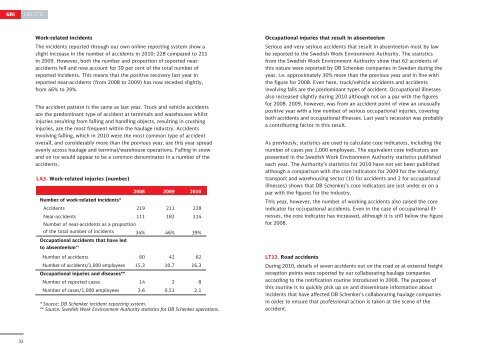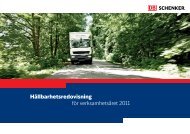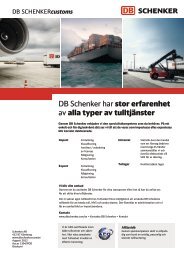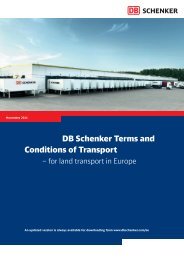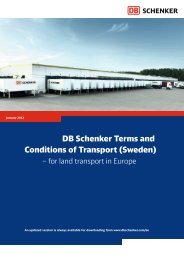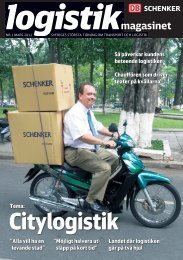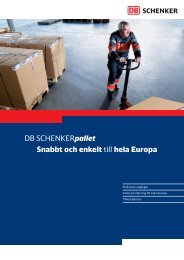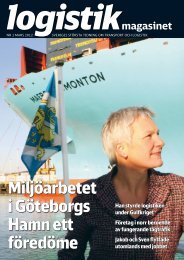PDF Download - Schenker
PDF Download - Schenker
PDF Download - Schenker
Create successful ePaper yourself
Turn your PDF publications into a flip-book with our unique Google optimized e-Paper software.
GRI<br />
LA5, LT12<br />
Work-related incidents<br />
The incidents reported through our own online reporting system show a<br />
slight increase in the number of accidents in 2010: 228 compared to 211<br />
in 2009. However, both the number and proportion of reported nearaccidents<br />
fell and now account for 39 per cent of the total number of<br />
reported incidents. This means that the positive recovery last year in<br />
reported near-accidents (from 2008 to 2009) has now receded slightly,<br />
from 46% to 39%.<br />
The accident pattern is the same as last year. Truck and vehicle accidents<br />
are the predominant type of accident at terminals and warehouses whilst<br />
injuries resulting from falling and handling objects, resulting in crushing<br />
injuries, are the most frequent within the haulage industry. Accidents<br />
involving falling, which in 2010 were the most common type of accident<br />
overall, and considerably more than the previous year, are this year spread<br />
evenly across haulage and terminal/warehouse operations. Falling in snow<br />
and on ice would appear to be a common denominator in a number of the<br />
accidents.<br />
LA5. Work-related injuries (number)<br />
2008 2009 2010<br />
Number of work-related incidents*<br />
Accidents 219 211 228<br />
Near-accidents 111 182 114<br />
Number of near-accidents as a proportion<br />
of the total number of incidents 34% 46% 39%<br />
Occupational injuries that result in absenteeism<br />
Serious and very serious accidents that result in absenteeism must by law<br />
be reported to the Swedish Work Environment Authority. The statistics<br />
from the Swedish Work Environment Authority show that 62 accidents of<br />
this nature were reported by DB <strong>Schenker</strong> companies in Sweden during the<br />
year, i.e. approximately 30% more than the previous year and in line with<br />
the figure for 2008. Even here, truck/vehicle accidents and accidents<br />
involving falls are the predominant types of accident. Occupational illnesses<br />
also increased slightly during 2010 although not on a par with the figures<br />
for 2008. 2009, however, was from an accident point of view an unusually<br />
positive year with a low number of serious occupational injuries, covering<br />
both accidents and occupational illnesses. Last year’s recession was probably<br />
a contributing factor in this result.<br />
As previously, statistics are used to calculate core indicators, including the<br />
number of cases per 1,000 employees. The equivalent core indicators are<br />
presented in the Swedish Work Environment Authority statistics published<br />
each year. The Authority’s statistics for 2010 have not yet been published<br />
although a comparison with the core indicators for 2009 for the industry/<br />
transport and warehousing sector (10 for accidents and 2 for occupational<br />
illnesses) shows that DB <strong>Schenker</strong>’s core indicators are just under or on a<br />
par with the figures for the industry.<br />
This year, however, the number of working accidents also raised the core<br />
indicator for occupational accidents. Even in the case of occupational illnesses,<br />
the core indicator has increased, although it is still below the figure<br />
for 2008.<br />
Occupational accidents that have led<br />
to absenteeism**<br />
Number of accidents 60 42 62<br />
Number of accidents/1,000 employees 15.3 10.7 16.3<br />
Occupational injuries and diseases**<br />
Number of reported cases 14 2 8<br />
Number of cases/1,000 employees 3.6 0.51 2.1<br />
* Source: DB <strong>Schenker</strong> incident reporting system.<br />
** Source: Swedish Work Environment Authority statistics for DB <strong>Schenker</strong> operations.<br />
LT12. Road accidents<br />
During 2010, details of seven accidents out on the road or at external freight<br />
reception points were reported by our collaborating haulage companies<br />
according to the notification routine introduced in 2008. The purpose of<br />
this routine is to quickly pick up on and disseminate information about<br />
incidents that have affected DB <strong>Schenker</strong>’s collaborating haulage companies<br />
in order to ensure that professional action is taken at the scene of the<br />
accident.<br />
32


